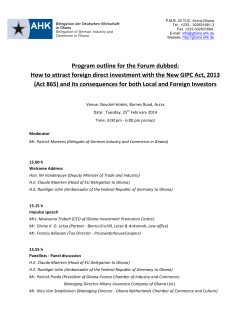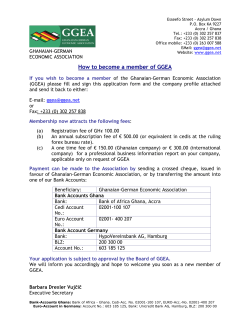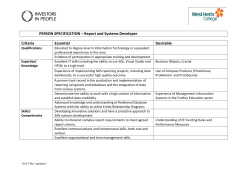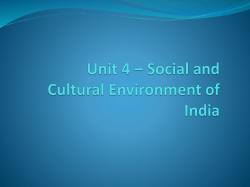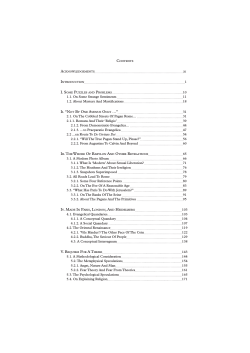
(Mis)representation of religions in Religious Education, and the “making” of Abstract
Richardson Addai-Mununkum University of Wisconsin-Madison addaimununku@wisc.edu REA Annual Meeting November 7-9, 2014 (Mis)representation of religions in Religious Education, and the “making” of religious violence Abstract Little research has been done to examine how religious education curricula represent religions and the effects of such representations on students' behavior. This paper examines religious education curricula of Ghanaian schools and reveals that whilst Christianity is presented as the standard religion, Indigenous Religion and Islam are misrepresented as inferior, yet, worth tolerating. Given that the flourishing of religious misrepresentations can lead to the suppression of minority views and incitement to hatred, I examine the connection of such misrepresentations to the "making" of religious violence. Religious Mis(representation) The inclusion of religion in public school curriculum around the world attracts both support and criticism. For most critics, religious education can become a proselytization tool, or worse still, cause disaffection emanating from religious misrepresentation. While a lot of work has been done in literature to distinguish teaching about religion from teaching from religion (Wright, 2008; AAR, 2010; NCSS, 1984), the same attention has not been devoted to misrepresentation of religion in the curriculum. The lack of scholarship in this area is regrettable, for misrepresentation can lead to hatred for the ‘other,’ and if done to the extreme, can ultimately “make” violence. I define religious (mis)representation as a phenomenon in curriculum discourse where a particular religion is presented or taught about in a manner that is displeasing to adherents of that religion. (Mis)representation of religion is far more pronounced in curricular materials than educators would readily admit. This is because texts are integral to the creation and legitimation of ideologies, beliefs, knowledge and values of the dominant in a given society (Crowford, 2003). Thus, such materials become the tools for misrepresentations that subjugate specific groups through the twisting, massaging and removal of facts. In the words of Pingel, (2010) curricular materials could be constructed to shape discourses to the advantage of powerful groups in societies. For instance, Dalton (2014) observes that the desire by teachers and parents to work with “tamed” children results in production and circulation of texts that present the boyhood 1 This work was supported by Scott Kloeck-Jenson Fellowship (UW-Madison Global Studies), and Netzer-Wendt Fellowship of UW-Madison School of Education. nature of Jesus as meek and mild. Additionally, Hammad (2014) identifies Islamic Science textbooks as lacking the transmission of high-order thinking skills because some Islamic traditions glorify teachers and make students subject to their dictates. Taken together, the quest by powerful groups to maintain their influence in society could manifest in curricular materials that are skewed to favor the status quo. It is therefore important that texts are not viewed as sacrosanct, but materials that arise out of contestation (Apple, 2000). With REA’s renewed commitment towards the “unmaking” of violence, I see the (mis)representation of religion in curricula as a threat to creating and maintaining religious harmony, hence requiring critical inquiry. Research has long recognized what the flourishing of religious (mis)representation can lead to: the suppression of minority views, resentment towards persons of different faiths, holding of entrenched opinions about one’s religion, insensitivity to others’ beliefs, and even incitement to hatred (Subedi, 2006; AAR, 2010; Hess 2008; Jackson 1995). All these outcomes cannot be dissociated from violence and religious conflicts around the globe. Hence, working towards an understanding of the phenomenon of (mis)representation ought to be an issue of concern to religious educators globally. This paper is written out of the context of Ghana, a religiously plural country on the west coast of Africa where a multi-faith religious education program is mandated in all public schools. Since the 1970s when efforts were made to integrate different religious education programs into a single subject of study, practical challenges have been identified. Notable among these is the continuous suspicion by parents that their children are not being provided the religious education (RE) they desire (Kudadjie, 1996). In fact, Christians, Muslims and adherents of Indigenous Religion (IR) have at different times challenged aspects of RE (Kudadjie, 1996, Thomas, 2012, Joy News 2012). Although such controversies have not resulted in violent acts, it is important that attention be devoted to them because of their potential long term deleterious effects. As part of a broader research that examines the representation of religion in schools in Ghana, this paper explores the following question: How are religions represented in RE text of elementary schools in Ghana? RE text stated here includes: the national syllabus of a compulsory subject called Religious and Moral Education (RME), and three textbooks of RME published by private publishers. My interest in this broader question lies in untangling whose religious values are espoused in the elementary school curricula, whose values are missing or denigrated, and the possible outcomes. RE Curriculum in Ghana Elementary school curriculum in Ghana is centralized such that syllabi, textbooks and other teaching and learning materials are uniformly published and distributed by the government throughout the country. Consequently, the national RME syllabus published by the Ghana Education Service (GES) is the “standard” curricular material for RE and is expected to be implemented throughout the country. Research has confirmed a widely held claim that official textbooks in Ghana are rarely supplied to schools (Oduro, 2013; Owen et al, 2005), and if they are, they do not make it to the hands of students (Okyere et al, 1997). This results in only onetenth of pupils in schools in Ghana with textbooks in the core subjects, a category which includes RME (Okyere et al, 1997; Opoku Amankwaa, 2010; Amoah, 2012). In my survey of seven schools in a metropolitan area in mid Ghana, none had copies of the official RME textbooks, 2 leaving teachers to resort to those published by private publishers. As expected, the vacuum created by the absence of the government approved textbooks has been filled by private individuals and businesses whose motivation for intervention has profit as the bottom line. As the texts were absent in many cases, I examined the national syllabus to represent the official curriculum. In a tabular fashion, the syllabus outlines themes (grouped into sections), topics, objectives, core knowledge, teaching and learning activities, and assessment activities for every grade. In addition to the national syllabus, I examined three textbooks published by private publishers. The choice of these books was based on their popularity in a school district of interest for my research. Religious and Moral Education for Junior High Schools (hereafter referred to as Gateway) written by William K. Nwinam was published by Gateway to Success Publishers and covers the curriculum of junior high school (middle school). Its 409 pages are filled with content (text and pictures) as well as exercises at the end of each of the seventeen chapters. New Golden publishers also have six different books on Religious and Moral Education for each of the six classes of primary school. All the books were written by Alexander Okyere Baafi. For this analysis, I will use his book Religious and Moral Education for basic six pupils (hereafter referred to as Golden). The third book, Religious and Moral Education with Excellent Victory (hereafter identified as Victory) does not reveal the publishers of the book. The text is authored by Felix Djan Foh who describes himself as an “educationist/socio-political commentator”. His book is written for junior high students and was published in 2006. It contains 89 pages of text with no pictures or illustrative diagrams. It is written in point to point format with no room for elaborate discussion of the content. As curious as I was to identify the authors’ positionalities in terms of their religious affiliations, nothing in print acknowledges their subjectivities. The books are written and presented as value neutral, suggesting its suitability for all students regardless of their religious identities. Critical Discourse Analysis I ground this paper theoretically and methodologically in Critical Discourse Analysis (CDA) (Gee, 2004) to examine how authors and publishers represented Christianity, Islam and Indigenous Religion (IR). My main goal is to make visible and transparent, the "opaque structural relationships of dominance, discrimination, power and control as manifested in text" (Wodak 1995 in Blommaet & Buleaen 2000 p. 448). Van Dijk ( 1996) defines CDA as “analytical research that primarily studies the way social power abuse, dominance, and inequality are enacted, reproduced, and resisted by text and talk in the social and political context” (p. 352). CDA is built on the premise that society is inherently unjust and that what has become accepted as social norms work to the advantage of the dominant. Such normalization finds itself in language which becomes the embodiment of “acceptable standards” and influences not just by what is said, but who, when and how it is said. The task of CDA therefore is to unearth such inequalities and draw attention to them. CDA uniquely positions research to focus on language in use and its embodied meanings that would traditionally escape the attention of other theories. I share Van Dijk’s (1996) view that “scholarly discourse is inherently part of and influenced by social structure, and produced in social interaction” (p 153). I therefore aim to explore the relationships that exists in texts to understand how they arise out of and or are shaped by struggles for power (Fairclough 1993) over whose knowledge should count as official (Apple, 2000) 3 To answer the research question, data from the textual curricula materials were analyzed using Madison’s (2005) point of view analysis strategy. By point of view analysis, the researcher creates a point of view or a stance that signals the theoretical perspective of the study (Creswell, 2007). The choice of this strategy was informed by the critical nature of the study and its theoretical alignment with CDA. Three themes emerged from the analysis which I consider as forms of religious (mis)representation and the “making of violence”. Us versus Them: Polarization by identification My analysis revealed that the texts’ representation of religions was done in tandem with the association and dissociation of authors from the different religions. Authors’ use of personal possessive and objective pronouns “their” and “our” could hardly escape my attention. Consider the following statements: The pouring of libation is the form of prayer by the traditional believers to their lesser gods. (Victory, p.25) Festivals are part of every religion and so Muslims have theirs that they celebrate every year. (Golden, p.74) It is even more interesting when compared with: Christians believe in Jesus Christ …… but was crucified and died for our sins. (Victory, p. 25) and God’s love toward us draws us to Himself and by His love towards us, He (God) called us his sons. (Victory, p.53) These statements expose the perceived neutrality of the authors of Victory and Golden. Although each book is introduced with the premise of neutrality, the authors’ associations based upon possessive pronouns function to lay bare their hidden loyalty. They, through the text show that they believe Jesus died for “our” sins. “Our” here includes the author and any other person who identifies with that group’s beliefs. In contrast, traditional believers pray to “their” lesser gods, and Muslims have “their” festival, implying that the authors of Victory and Golden, dissociate themselves from these religions, and by extension expect readers to do same. By the simple use of pronouns, the authors create a divide between followers of Christianity and others, making Christianity the privileged religion, while (mis)representing IR and Islam as inferior and existing as ‘other’ (Said, 1979). The fundamental ideas behind the two statements would change significantly if the pronouns were omitted for them to read: “The pouring of libation is the form of prayer by the traditional believers to lesser gods” and “Christians believe in Jesus Christ …. but was crucified and died for believers’ sins”. Apple (1992) and Crowford (2003) write that texts are not neutral. This is because they are written by people who are influenced by society, who have their own biases, and work within the political and economic constraints of the market. Though no text can be truly neutral, exclusionary practices regarding RE cannot continue in our quest for religiously inclusive classrooms. The “us versus them” divide has been the starting point of most conflicts. As Wondolleck et al (2003) put it, “they play a pivotal role in the emergence, evolution, and intractability or resolvability of a conflict” (p. 207). Other conflict prevention literature also warn that dichotomous “us versus them” has embedded in it, a belief of moral superiority of the dominant and combined with feelings of disenfranchisement for the subaltern, it may make 4 terrorism considerably more likely (Schwartz, Dunkel & Waterman, 2009). Ours is better: Christianity as model religion Postcolonial literature is replete with an expose of representational practices of colonialists who viewed Christianity as the norm and all other religions as “the other”. In fact, Jackson (1995) argues that the introduction of comparative religion as a discipline in 1944 was in part to compare religions in order to show the superiority of Christianity. Decades after postcolonial “enlightenment”, my study revealed the representation of Christianity as a model for all other religions. Like the years past, Islam and IR are compared to Christianity in order to identify and highlight their shortcomings. For instance, in some text analyzed (Gateway and Golden), Jesus performing healing miracles is constructed to be the exemplar, and founders of other religions are judged on their ability to perform similar miracles. Consider the following comparison of leaders of three faiths - Christianity, Islam and IR, (Jesus, Muhammad and Okomfo Anokyei). concerning healing it has never crossed my ears that Anokye healed someone of an illness or a disease. (Gateway, p.63) on the part of healing it is not known that he [Muhammad] performed any. (Golden, p.68) Okomfo Anokye is presented in the Golden and Gateway texts as a traditional priest who had power and the ability to perform miracles that saved the Ashanti kingdom of the fifteenth century. Yet Gateway and Golden highlight his lack of supernatural powers in their contrast of his powers with that of Jesus. The absence of information relating to Okomfo Anokye and Muhammad’s ability to heal the sick functions to give the impression that they are less powerful than Jesus. Moreover, the presentation of sentences of similar import about Okomfo Anokye and Muhammad in both texts goes to emphasize my argument about demeaning comparisons. A more balanced treatment of the religions is possible, given that there were miracles performed by Okomfo Anokye and Muhammad that Jesus is not known to have done. Golden mentions Muhammad miraculously made water flow from his fingers for his followers to drink, whereas Gateway records that Okomfo Anokye commanded a golden stool from the sky. In discussing Jesus’s miracles, none of the books query Jesus’ inability to perform similar miracles. Moreover, Gateway and Golden are not alone in their representation of Christianity as a superior religion. Christian worship day is described by the national syllabus as “normal Sunday/Saturday service” (Syllabus, p.48). By extension, readers can imply that other worship days are “not normal”, “unacceptable” and strange. It is in the same vein that Golden series writes that: “Christmas is the time God blesses the world” (Golden p. 69). To cap it, Christianity is made a standard religion whereas Islam and IR are misrepresented as counterfeit religions that strive, but are unable to match up to the “original”. The quest to see Christianity as the “norm” and IR as the “other” can again be explained in line with Fairclough’s (1993) representational practices. He defines representation as “relation between two entities - x is different from y” (p25). Representation thrives on a clear distinction between two entities and all acts at description aim to make such distinctions clearer. In this instance, Christianity is made distinct from other religions and this representational practice builds on the “us versus them” divide to further polarize participants in classroom discourse even further. 5 You should go with ours: Religion of choice The two other representational practices take on a third form in which authors make it imperative for the reader to choose a single religion. The material examined revealed value embedded statements recommending “universal” Christian values be upheld by students. An example of this can be seen in the following statements: According to new life good news Bible which is ideal for everyone, before God created the universe, the earth was formless and desolate, and in total darkness. (Golden p.8) Humankind is created to serve God. That is why we must worship God only, and obey His instructions, laws and commandments. (Gateway p.11) Curricular texts here are not just passing information. They are making recommendations based on the value judgments of their authors for students to read the new life good news Bible because it is ideal for everyone, and to worship God only because humankind is created to serve God. It becomes even clearer when such statements are understood within a postcolonial mindset. Missionaries who arrived in the Gold Coast in the thirteenth century denigrated IR, and were largely successful at separating indigenes from their religion in order to introduce them to Christianity. Indigenous religious practices were therefore described as barbaric, heathen, totemic, polytheistic and uncouth (Beyers, 2010). Since then the relationship between IR and western religions (Christianity in particular) has been strained. I see the statement “that is why we must worship God only” as semantic innuendo aimed at portraying IR adherents as worshiping “many gods” and not believing in the Bible. The otherness of such Islamic and indigenous religious practice stands in sharp contrast to Christianity, because it deviates from the "norm” of reading the good news bible and worshiping God alone. Conclusion My analysis shows that the representational practices of authors of the curricular materials position Christianity as a standard religion and provide legitimacy for its content. IR and Islam are considered the “other”, marginalized and misrepresented as unequal in status to the “standard” Christianity (Jackson, 1995). Taken together, the RE curriculum which is meant to uphold religious pluralism and promote peaceful coexistence of different religions can be understood to be marginalizing Islam and IR.. This is extremely dangerous considering that most classrooms in Ghana are religiously plural. If students of religions other than Christianity are exposed to such content, they could harbor ill-feeling about other religions and resent adherents of majority faith traditions, which could ultimately lead to religious tension and conflicts over time. Conflict prevention literature has warned that while marginalization might appear to be harmless initially, it results in escalating violence in the long term (Yiftachel 2004). People respond to oppression differently. In face of religious misrepresentations in classrooms, other students might resort to violent means to settle emotional scores because of religions’ connection with histories and identities of individuals (Peek, 2005). RE has been acknowledged the world over for promoting religious dialogue and tolerance; it could also become the source of conflict and violence if misrepresentations persist. If RE is to make headway in championing the “unmaking” of violence, authors should acknowledge their complicit role in the making of violence, and institute appropriate safeguards. I am arguing here that such seemingly harmless biases in the curriculum coupled with nuances of presentation informed by teachers’ religious identity, students’ religious identity and school religious climates 6 make classrooms unwelcoming, especially for students who do not share in the normative religion. With connections drawn between marginalization, misrepresentation, bias and hatred, fanaticism, (Hess 2008, Jackson 1995, Faour, 2012, AAR, 2010) the way to (un)make religious violence is for RE research to focus on happenings in classrooms and draw attention to religious (mis)representations. Further research is needed in areas relating to school character and religious representations, teacher religious identity and misrepresentations as well as students representation of “other” religions. References: American Academy of Religion [AAR]. (2010). Guidelines for Teaching about Religion in K-12 Public Schools in the United States (p. 36). American Academy of Religion. Retrieved from https://www.aarweb.org/sites/default/files/pdfs/Publications/epublications/AARK12CurriculumGuidelines.pdf Amoah, A. K. (2012). When Schools lack Textbooks [News]. Retrieved from http://www.ghanaweb.com/GhanaHomePage/features/artikel.php?ID=233347 Apple, M. W. (1992). The Text and Cultural Politics. Educational Researcher, 21(7), 4–19. Apple, M. W. (2000). Official Knowledge: Democratic Education in a Conservative Age. New York: Routledge. Beyers, J. (2010). What is religion? An African understanding. HTS Teologiese Studies / Theological Studies, 66(1). Blommaert, J., & Buleaen, C. (2000). Critical Discourse Analysis. Annual Review of Anthropology, 29, 447–466. Creswell, J. W. (1998). Five qualitative traditions of inquiry. Qualitative Inquiry and Research Design: Choosing among Five Traditions, 47–72. Crowford, K. (2003). The Role and Purpose of Textbooks. International Journal of Historical Learning, Teaching and Research, 3(2), 5–10. Dalton, W. R. (2014). Meek and Mild: American Children’s Bibles’ Stories of Jesus as a Boy. Religious Education, 109(1), 45–60. Djan, F. F. (2006). Religious and Moral Education in Excellent Victory. Fairclough, N. (1993). Critical discourse analysis and the marketization of public discourse: The universities. Discourse & Society, 4(2), 133–168. Faour, M. (2012, August 13). Religious Education and Pluralism in Egypt and Tunisia. Carnegie Endowment for International Peace. Gee, J. P. (2004). Discourse Analysis: What makes it critical? In R. Rogers (Ed.), An Introduction to Critical Discourse Analysis in Education. Routledge. Ghana Education Service. (2008). Teaching Syllabus for Religious and Moral Education (Primary 1-6). Ghana Education Service. Hammad, H. A. A. (2014). Role of Islamic Science Textbooks and Teaching Methods in Arab Schools and Universities and Ideological Extremism. Religious Education, 109(1), 61–71. Hess, D. (2008). Controversy in the Classroom: the democratic power of discussion. London: Routledge. Jackson, R. (1995). Religious Education’s Representation of “Religions” and “Cultures.” British Journal of Educational Studies, 43(3), 272–289. Joy News. (2012). Don’t force Muslim students into Christian worship – Prez Mahama. Retrieved December 16, 2012, from 7 http://edition.myjoyonline.com/pages/news/201210/96199.php Kudadjie, J. (1996). Challenges facing religious education and research in Africa: The Ghana case. The British Journal of Religious Education, 4, 180–193. Madison, D. S. (2005). Critical Ethnography. California: SAGE Publications. National Council for the Social Studies. (1984). Study about Religions in the Social Studies Curriculum. Retrieved March 25, 2014, from http://www.socialstudies.org/positions/religion Nwinam, W. K. (2004). Religious and Moral Education for Junior High schools. Accra, Ghana: Gateway to Success. Oduro, G. K. T. (2013, August). Reversing the Lowering Standards of Education at the Pretertiary level in Ghana: The Role of Stakeholders’. Address presented at the Regional Delegates Conference of GNAT, Ho. Okyere, B. A. (n.d.). Religious and Moral Education for Basic Six. Kumasi: New Golden Publications. Okyere, B., Mensah, A., Kugbey, H., & Harris, A. (1997). What happens to the Textbooks (p. 16). American Institute of Research. Retrieved from http://www.ieq.org/pdf/textbooks.pdf Opoku-Amankwa, K. (2010). What happens to textbooks in the classroom? Pupils’ access to literacy in an urban primary school in Ghana. Pedagogy, Culture & Society, 18(2), 159–172. Owen, W. E., Randolph, L., Casely-Hayford, R., O’Shaughnessy, W., & Snyder, E. (2005). The final evaluation of USAID/Ghana’s quality improvement in primary schools (QUIPS) programme. Accra: USAID Ghana. Peek, L. (2005). Becoming Muslim: The development of a religious identity. Sociology of Religion, 66(3), 215–242. Pingel, F. (2010). UNESCO Guidebook on Textbook Research and Textbook Revision (Second.). Hannover: Verlag Hahnsche Buchhandlung. Said, E. W. (1979). Orientalism. New York: Random House LLC. Schwartz, S. J., Dunkel, C. S., & Waterman, A. S. (2009). Terrorism: An identity theory perspective. Studies in Conflict & Terrorism, 32(6), 537–559. Subedi, B. (2006). Preservice Teachers’ Beliefs and Practices: Religion and Religious Diversity. Equity & Excellence in Education, 39(3), 227–238. Thomas, P. (2012). Religious Education and the Feminisation of Witchcraft: A Study of Three Secondary Schools in Kumasi, Ghana. British Journal of Religious Education, 34(1), 67–86. Van Dijk, T. A. (1996). Discourse, power and access. In C. R., Coulthard, Malcolm CaldasCoulthard (Ed.), Texts and practices: readings in critical discourse analysis. London [u.a.: Routledge. Wondolleck, J. M., Gray, B., & Bryan, T. (2003). Us versus Them: How Identities and Characterizations Influence Conflict. Environmental Practice, 5(03), 207–213. Wright, A. (2008). Critical Religious Education and the National Framework for Religious Education in England and Wales. Religious Education, 103(5), 517–521. Yiftachel, O. (2004). Ethnocratic States and Spaces. Presented at the United States Institute for Peace Lecture, Washington DC. Retrieved from http://www.usip.org/events/ethnocraticstates-and-spaces i Okomfo Anokye is a traditional priest of historical significance. The Ashantis of Ghana revere his heroic and miraculous acts that saved their kingdom 8
© Copyright 2025
